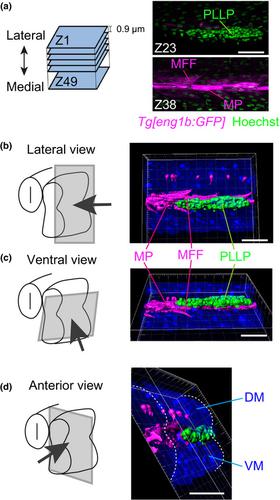当前位置:
X-MOL 学术
›
Genes Cells
›
论文详情
Our official English website, www.x-mol.net, welcomes your
feedback! (Note: you will need to create a separate account there.)
Relationship between surrounding tissue morphology and directional collective migration of the posterior lateral line primordium in zebrafish.
Genes to Cells ( IF 1.3 ) Pub Date : 2020-06-09 , DOI: 10.1111/gtc.12793 Akari Karaiwa 1 , Sohei Yamada 2 , Hodaka Yamamoto 1 , Mizuho Wakasa 1 , Hannosuke Ishijima 1 , Ryutaro Akiyama 1 , Yoichiroh Hosokawa 2 , Yasumasa Bessho 1 , Takaaki Matsui 1
Genes to Cells ( IF 1.3 ) Pub Date : 2020-06-09 , DOI: 10.1111/gtc.12793 Akari Karaiwa 1 , Sohei Yamada 2 , Hodaka Yamamoto 1 , Mizuho Wakasa 1 , Hannosuke Ishijima 1 , Ryutaro Akiyama 1 , Yoichiroh Hosokawa 2 , Yasumasa Bessho 1 , Takaaki Matsui 1
Affiliation

|
Collective cell migration, in which cells assemble and move together, is an essential process in embryonic development, wound healing and cancer metastasis. Chemokine signaling guides cell assemblies to their destinations. In zebrafish posterior lateral line primordium (PLLP), a model system for collective cell migration, it has been proposed that the chemokine ligand Cxcl12a secreted from muscle pioneer cells (MPs) and muscle fast fibers (MFFs), which are distributed along with the horizontal midline, binds to the receptor Cxcr4b in PLLP and that Cxcl12a–Cxcr4b signaling guides the anterior‐to‐posterior migration of PLLP along the horizontal midline. However, how the surrounding tissues affect PLLP migration remains to be elucidated. Here, we investigated the relationship between the PLLP and the surrounding tissues and found that a furrow between the dorsal and ventral myotomes is generated by Sonic hedgehog (Shh) signaling‐dependent MP and MFF differentiation and that the PLLP migrates in this furrow. When transient inhibition of Shh signaling impaired both the furrow formation and differentiation of cxcl12a‐expressing MPs/MFFs, directional PLLP migration was severely perturbed. Furthermore, when differentiated MPs and MFFs were ablated by femtosecond laser irradiations, the furrow remained and PLLP migration was relatively unaffected. These results suggest that the furrow formation between the dorsal and ventral myotomes is associated with the migratory behavior of PLLP.
中文翻译:

斑马鱼周围组织形态与后侧线原基的定向集体迁移之间的关系。
细胞在其中聚集并移动的集体细胞迁移是胚胎发育,伤口愈合和癌症转移的重要过程。趋化因子信号传导将细胞装配体引导至目的地。在斑马鱼后侧原基(PLLP),一个集体细胞迁移的模型系统,有人提出趋化因子配体Cxcl12a分泌的肌肉先锋细胞(MPs)和肌肉快纤维(MFFs),与水平一起分布中线与PLLP中的受体Cxcr4b结合,并且Cxcl12a–Cxcr4b信号引导PLLP沿水平中线从前向后迁移。但是,周围组织如何影响PLLP迁移仍有待阐明。这里,我们研究了PLLP与周围组织之间的关系,发现通过声波刺猬(Shh)信号依赖的MP和MFF分化产生了背侧和腹侧肌层之间的沟,并且PLLP在此沟中迁移。当瞬时抑制Shh信号传导同时破坏了犁沟的形成和分化cxcl12a表达MP / MFF,PLLP定向迁移受到严重干扰。此外,当飞秒激光辐照消除分化的MPs和MFFs时,犁沟仍然存在,而PLLP迁移相对不受影响。这些结果表明,在背侧和腹侧肌层间的沟形成与PLLP的迁徙行为有关。
更新日期:2020-08-11
中文翻译:

斑马鱼周围组织形态与后侧线原基的定向集体迁移之间的关系。
细胞在其中聚集并移动的集体细胞迁移是胚胎发育,伤口愈合和癌症转移的重要过程。趋化因子信号传导将细胞装配体引导至目的地。在斑马鱼后侧原基(PLLP),一个集体细胞迁移的模型系统,有人提出趋化因子配体Cxcl12a分泌的肌肉先锋细胞(MPs)和肌肉快纤维(MFFs),与水平一起分布中线与PLLP中的受体Cxcr4b结合,并且Cxcl12a–Cxcr4b信号引导PLLP沿水平中线从前向后迁移。但是,周围组织如何影响PLLP迁移仍有待阐明。这里,我们研究了PLLP与周围组织之间的关系,发现通过声波刺猬(Shh)信号依赖的MP和MFF分化产生了背侧和腹侧肌层之间的沟,并且PLLP在此沟中迁移。当瞬时抑制Shh信号传导同时破坏了犁沟的形成和分化cxcl12a表达MP / MFF,PLLP定向迁移受到严重干扰。此外,当飞秒激光辐照消除分化的MPs和MFFs时,犁沟仍然存在,而PLLP迁移相对不受影响。这些结果表明,在背侧和腹侧肌层间的沟形成与PLLP的迁徙行为有关。











































 京公网安备 11010802027423号
京公网安备 11010802027423号